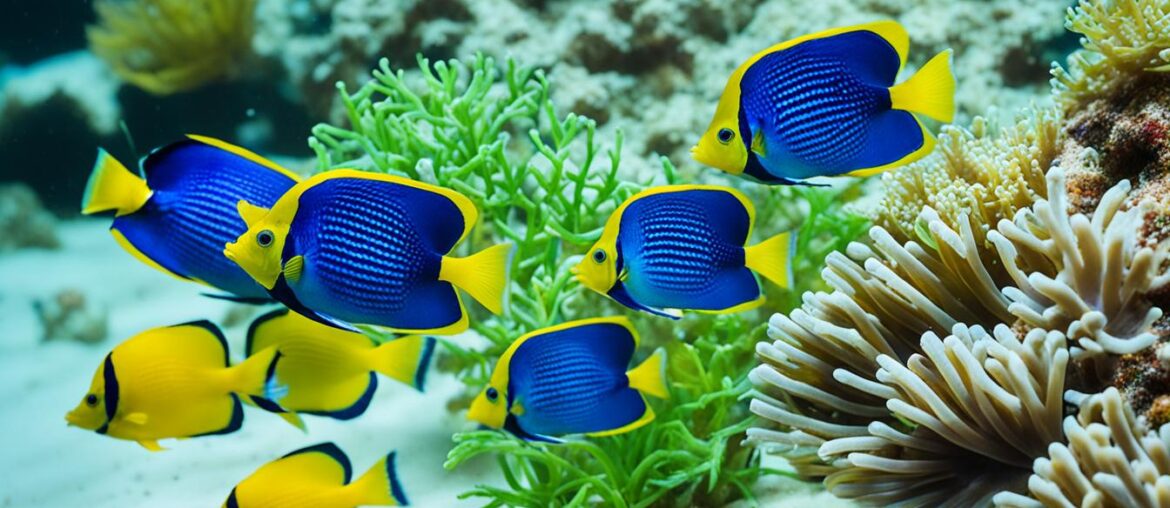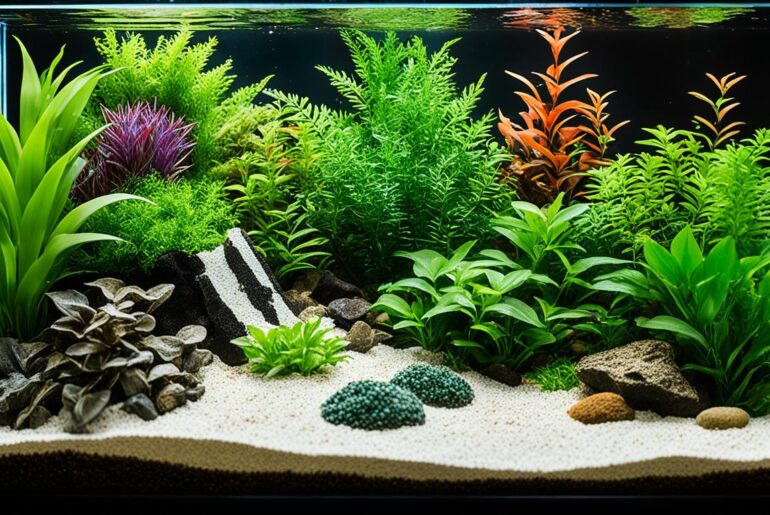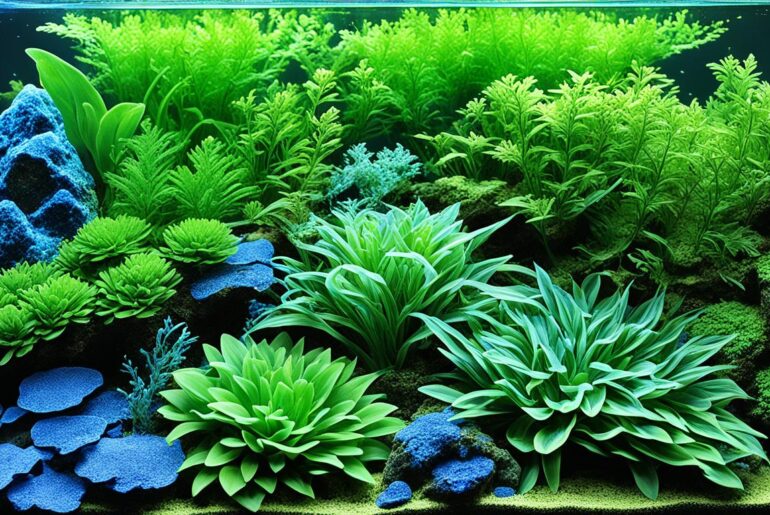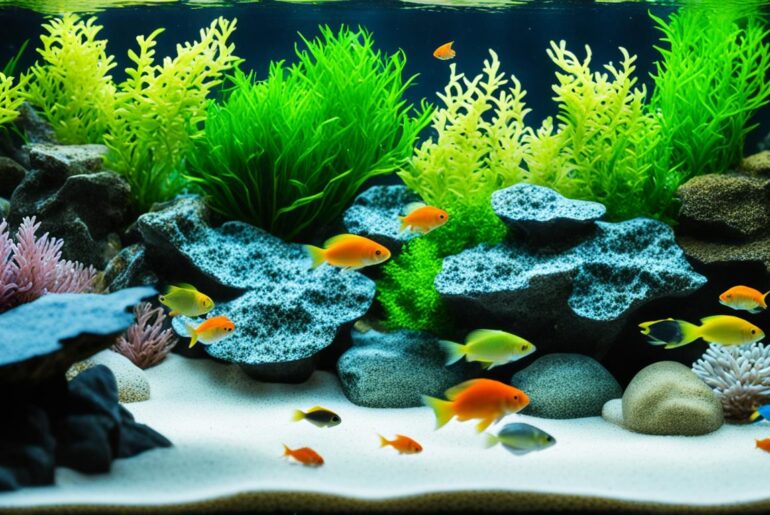Growing up, my love for aquariums was unparalleled. I would spend hours mesmerized by the shimmering colors and graceful movements of the fish. Little did I know then, the subtle yet profound impact that the color of the aquarium substrate had on their behavior.
From my personal experience and subsequent research, I discovered that aquarium substrates, such as gravel, sand, and clay, play a crucial role in shaping fish behavior. They affect everything from the fish’s habitat and breeding patterns to their stress levels and overall well-being. This newfound knowledge made me realize the importance of understanding how substrate color influences the behavior of our aquatic companions.
In this comprehensive guide, we dive deep into the impact of substrate color on fish behavior. We explore the findings of fish behavior studies and substrate color experiments to uncover the specific effects that different colors can have on our finned friends. By understanding these nuances, we can create aquariums that provide optimal environments for our fish to thrive.
Key Takeaways:
- The color of the aquarium substrate has a significant impact on fish behavior and well-being.
- Understanding the specific effects of different substrate colors can help create a thriving aquatic environment.
- Substrate color influences stress levels, feeding behaviors, natural instincts, and overall activity levels of fish.
- By mimicking the natural habitat of fish through substrate color, we can positively impact their behavior.
- Research and experiments in the field of fish behavior studies provide valuable insights into the effects of substrate color on fish behavior.
Benefits of Using Aquarium Substrate
When setting up an aquarium, the choice of substrate plays a vital role in creating an optimal habitat for fish. Aquarium substrates offer numerous benefits that contribute to the overall well-being of fish and the aquatic environment.
Creating Structure and Hiding Places
Aquarium substrates, such as gravel, sand, and clay, provide a foundation that allows fish to explore and establish territories. These substrates create structure and hiding places for fish and other organisms, mimicking the natural environment and reducing stress levels.
“The presence of substrate gives fish a sense of security, allowing them to exhibit their natural behaviors without constant stress or anxiety.”
Home for Beneficial Bacteria
Substrates not only benefit fish but also support the growth of beneficial bacteria. These bacteria contribute to the biological filtration process, helping to maintain water quality and support a healthy ecosystem within the aquarium.
“The beneficial bacteria residing in the substrate play a crucial role in breaking down waste products, converting harmful substances into less toxic forms.”
Improving Water Quality
Aquarium substrates enhance water quality by providing a medium for mechanical and biological filtration. The substrate traps debris, preventing it from circulating in the water column, and allows beneficial bacteria to colonize, further improving filtration efficiency.
Enhancing Aesthetic Appeal
The choice of substrate can also significantly impact the visual appeal of an aquarium. Different colors and textures of substrates can create a captivating underwater landscape, adding depth and dimension to the tank’s aesthetics.
“Choosing substrates that complement the overall theme and design of the aquarium can elevate its visual appeal and make it a centerpiece in any space.”
Research has shown that the type and color of substrate used can have a profound effect on fish behavior and overall well-being. By carefully selecting the right substrate, aquarium enthusiasts can create a natural and stimulating environment that promotes natural behaviors, reduces stress, and enhances the overall health and happiness of their fish.
| Benefits of Using Aquarium Substrate |
|---|
| Creating Structure and Hiding Places |
| Home for Beneficial Bacteria |
| Improving Water Quality |
| Enhancing Aesthetic Appeal |
Types of Aquarium Substrates: Gravel
Gravel is a popular choice for freshwater aquarium substrates due to its natural appearance and availability in various sizes and colors. It provides a textured and visually appealing base for the tank, mimicking the natural habitat of many aquatic species.
When selecting gravel for your aquarium, it’s important to consider the size and color that best suits your setup and fish species. Larger gravel particles are ideal for larger aquariums and fish, while smaller gravel is suitable for smaller tanks and fish, providing a more comfortable substrate for their movements.
But did you know that the color of gravel can also impact fish behavior? Research has shown that fish have different visual perceptions, and selecting substrate colors that mimic their natural habitat can positively influence their behavior and overall well-being.
Some fish species may show preferences for specific colors of the substrate. For example, brightly colored gravel may attract the attention of certain fish species, stimulating their activity levels and feeding behaviors. On the other hand, more subdued or natural-colored gravel can create a calming environment for fish that prefer a quieter and less stimulating habitat.
Incorporating substrate colors that align with your fish’s preferences can enhance their overall experience in the aquarium and reduce stress levels. By creating a visually appealing and stimulating environment with the right gravel color, you can promote natural behaviors and contribute to the overall health and happiness of your fish.
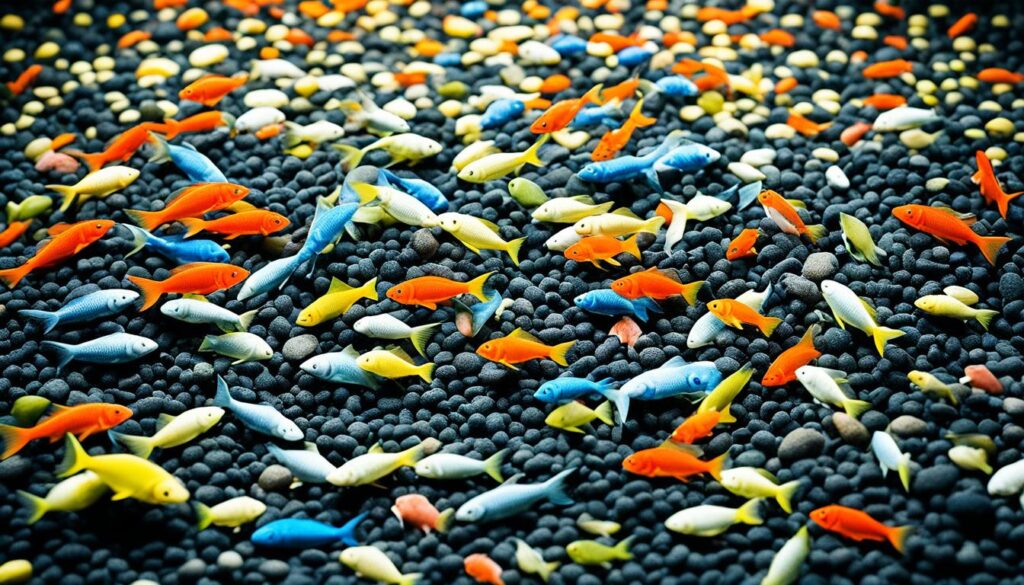
Benefits of Gravel as an Aquarium Substrate:
- Provides a natural and visually appealing look
- Mimics the natural habitat of many fish species
- Comes in various sizes to suit different tank setups
- Can positively influence fish behavior through the selection of appropriate colors
- Creates a comfortable substrate for fish movements
Considerations when using Gravel as Substrate:
- Choose the right size of gravel for your tank and fish species
- Select colors that mimic the natural habitat of your fish
- Ensure proper cleaning and maintenance to prevent debris buildup
- Regularly vacuum or stir the substrate to maintain water quality
- Monitor fish behavior and adjust the substrate if necessary
Types of Aquarium Substrates: Sand
Sand is another commonly used substrate for aquariums. It provides a natural and comfortable base for fish to swim on. The size and color of sand can have an impact on fish behavior, as some species may have preferences for finer grains or specific colors.
Finer grain sand allows for easier movement for smaller fish, while larger grain sand can potentially scratch delicate fish scales. Therefore, it is important to choose the right type of sand that suits the needs of your fish and its specific requirements.
Another consideration when selecting sand is the color. The color of sand can influence the overall visual appeal of the aquarium and potentially influence fish behavior as well. Some fish species may have preferences for certain colors or shades.
By choosing a sand color that complements the overall aesthetic of the tank and matches the natural habitat of the fish species, you can create a visually appealing and stimulating environment for your fish.
| Advantages of using sand as an aquarium substrate | Considerations when selecting sand |
|---|---|
|
|
Types of Aquarium Substrates: Clay
Clay is a popular substrate choice for aquariums due to its numerous benefits. It not only enhances the appearance of the tank but also plays a vital role in maintaining a healthy fish habitat. The use of clay substrates in aquariums has been extensively studied and researched, shedding light on the various effects it has on fish behavior and overall well-being.
Clay substrates offer improved filtration and oxygenation, benefiting both the fish and the ecosystem of the tank. They provide a natural environment that fish can thrive in, promoting their physical and mental well-being. Additionally, clay substrates encourage the growth of beneficial bacteria, which helps maintain water quality and balance.
One fascinating aspect of clay substrates is their impact on fish behavior, particularly in relation to color preferences. Research has shown that some fish species have specific color preferences when it comes to their habitat. By selecting clay substrates in colors favored by the fish species you keep, you can create a visually appealing and stimulating environment that closely replicates their natural habitats.
Creating an aquarium habitat that resembles their natural environment can positively influence fish behavior, reducing stress levels and promoting natural behaviors. By understanding the substrate color preferences of your fish species through research and observation, you can further enhance their overall well-being.
However, it’s important to note that installing and maintaining clay substrates require proper steps to ensure water clarity and stability. Regular cleaning and maintenance routines are necessary to prevent any negative effects on water quality and the health of your fish.
Benefits of Clay Substrates in Aquariums:
- Improved filtration and oxygenation
- Natural habitat for fish
- Promotes the growth of beneficial bacteria
Impact of Substrate Color on Fish Behavior
“Choosing clay substrates in colors favored by your fish species can create a visually appealing and stimulating environment that replicates their natural habitats.”
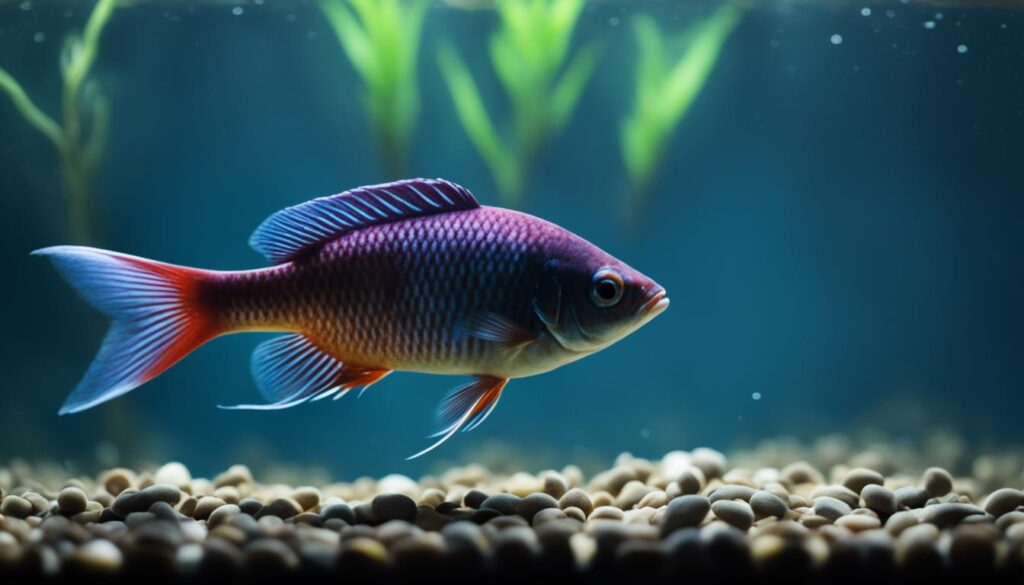
Comparison of Different Aquarium Substrates
| Substrate | Benefits | Considerations |
|---|---|---|
| Gravel | Provides structure and hiding places for fish Improves water filtration Comes in various colors and sizes |
May trap debris and require frequent cleaning Not suitable for fish species with sensitive barbels |
| Sand | Natural and comfortable Allows for easy movement for smaller fish |
May require specialized maintenance and cleaning techniques May cause cloudiness in the water |
| Clay | Improves filtration and oxygenation Provides a natural habitat for fish Encourages growth of beneficial bacteria |
Requires proper installation and maintenance for water clarity May affect water parameters if not monitored closely |
Overall, clay substrates offer numerous benefits for both the fish and the overall ecosystem of the aquarium. By understanding the impact of substrate color on fish behavior and considering the preferences of your fish species, you can create an aquarium environment that promotes natural behaviors and enhances their overall well-being.
Choosing the Right Aquarium Substrate
When it comes to selecting the perfect substrate for your aquarium, there are several factors to consider. Understanding the needs of your fish and the overall environment of the tank is crucial for creating a thriving aquatic habitat.
The first consideration is the size and shape of your aquarium. The type and color of substrate should align with the dimensions of the tank to ensure an optimal fit. A smaller tank may benefit from finer substrates, whereas larger tanks can accommodate coarser textures.
It’s important to note that different fish species have varying visual perceptions and preferences for substrate colors. By selecting colors that mimic their natural habitat, you can create a visually stimulating environment that positively influences their behavior and reduces stress.
Additionally, taking into account the size, weight, and natural food sources of your fish can guide you in determining the most suitable substrate type. Some fish species, like bottom-dwellers, may prefer sand as it allows them to easily sift through the substrate in search of food. On the other hand, larger fish may thrive with gravel substrates that offer better stability and a natural look.
Remember, the key to selecting the right aquarium substrate lies in research and understanding the specific needs of your fish. By considering their visual perception, natural preferences, and overall habitat requirements, you can create a visually appealing and stimulating environment that promotes their natural behaviors and overall well-being.
Check out the table below for a comprehensive comparison of different aquarium substrates:
| Substrate | Visual Appeal | Behavioral Impact | Recommended Fish Species |
|---|---|---|---|
| Gravel | Natural look, variety of colors | Affected by size and color | Tropical community fish, cichlids |
| Sand | Smooth texture, natural appearance | Affected by grain size and color | Bottom-dwelling fish, invertebrates |
| Clay | Elevated visual appeal, natural feel | Affected by coloration and texture | Plant-based aquariums, shrimp |
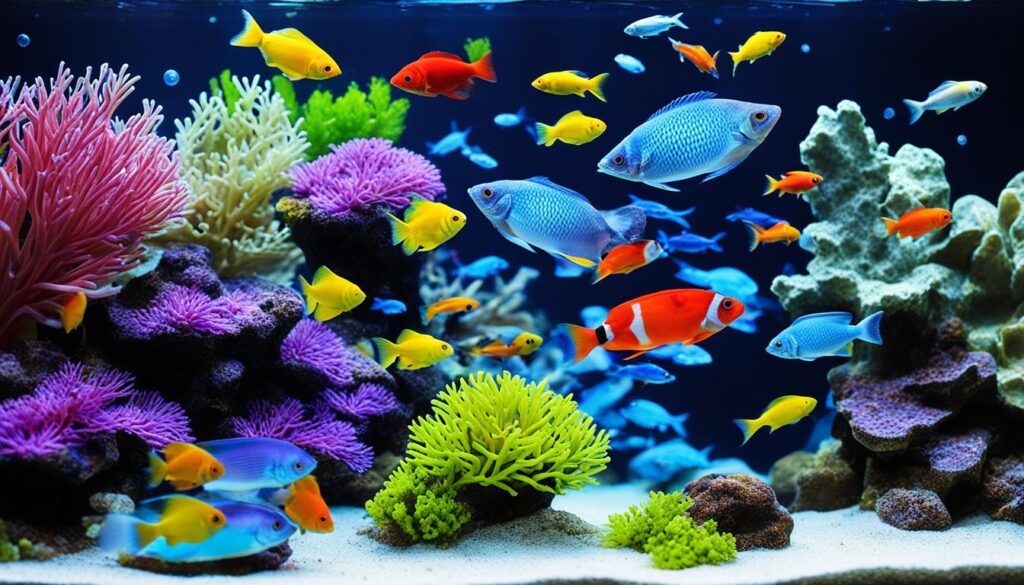
Visual perception plays a vital role in fish behavior, making substrate color preferences an important consideration. By understanding how different substrates impact fish behavior, you can create an environment that not only meets their physical needs but also engages them visually. Your fish will thrive in a habitat that closely resembles their natural surroundings, which can lead to reduced stress levels and a healthier overall well-being.
Installing and Maintaining Aquarium Substrate
In order to ensure the health and well-being of your fish, proper installation and maintenance of the aquarium substrate are crucial. By following these steps, you can create a healthy aquatic environment for your fish to thrive in.
- Clean and Prepare the Aquarium: Before installing the substrate, it is important to clean and prepare the aquarium. Remove any existing debris, algae, or waste from the tank.
- Evenly Layer the Substrate: Once the aquarium is clean, evenly layer the substrate on the bottom of the tank. Make sure to choose the appropriate type and color of substrate based on the needs of your fish species.
- Remove Excess Debris: To prevent water pollution and maintain water quality, remove any excess debris or particles that may have accumulated on top of the substrate.
- Regular Vacuuming or Stirring: It is important to regularly vacuum or stir the substrate to remove accumulated debris. This helps to maintain water clarity and prevent harmful substances from building up.
- Filter Changes and Water Changes: Periodically change the filters in your aquarium to ensure optimal filtration and oxygenation. Additionally, regular water changes are necessary to maintain a healthy aquatic environment.
- Follow Manufacturer Instructions: Always follow the manufacturer’s instructions when installing and maintaining the substrate. Different substrates may require specific steps or considerations to ensure proper care.
- Consider Fish Behavior and Natural Food Sources: Take into account the specific needs and behaviors of your fish when selecting and maintaining the substrate. Consider their natural habitat and food sources to provide the most suitable environment.
By following these guidelines and considering the research conducted on fish habitat and the aquatic environment, you can create a healthy and thriving aquarium for your fish.

In the next section, we will explore the significant role of substrate color on fish behavior and how it can impact their overall well-being.
The Role of Substrate Color on Fish Behavior
The color of aquarium substrate plays a vital role in influencing fish behavior. Different substrate colors have been found to impact fish stress levels, natural behaviors, and overall well-being. In fact, some fish species even show preferences for specific colors, which can significantly influence their activity levels and feeding behaviors.
Research studies have revealed that choosing substrate colors that mimic the natural habitat of fish can have a positive impact on their behavior and help reduce stress. By providing an environment that closely resembles their natural surroundings, we can create a sense of comfort and familiarity for the fish.
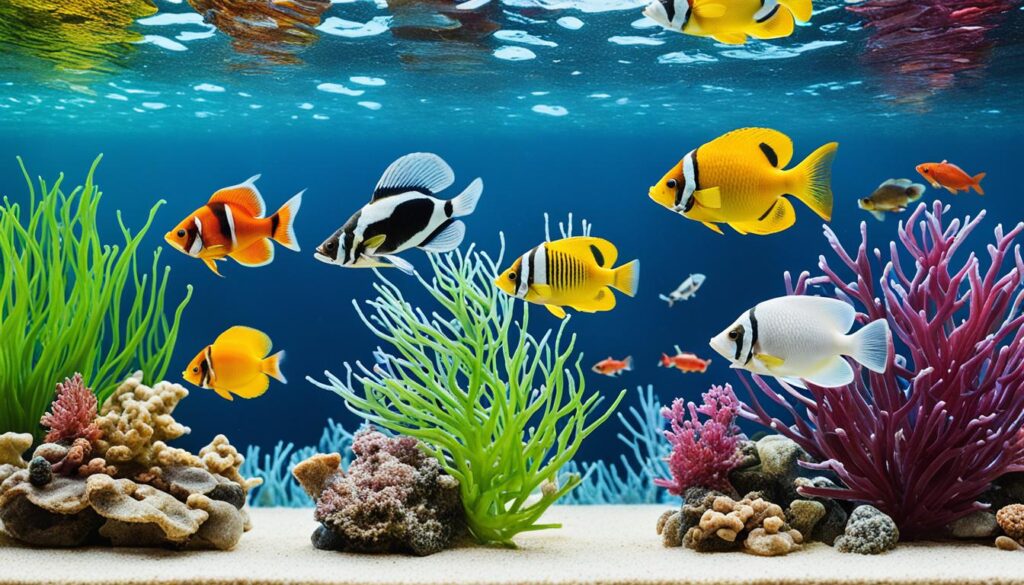
The Visual Perception Factor
Fish possess different visual perceptions, and their ability to perceive and respond to colors varies across species. Some fish species are more sensitive to certain colors than others. By selecting substrate colors that are visually appealing and compatible with the natural visual perception of the fish, we can create an environment that is visually stimulating and enriching for them. This can contribute to their overall health and happiness in the aquarium.
Environmental Enrichment and Natural Behaviors
The use of appropriate substrate colors can also provide environmental enrichment for fish. By recreating their natural habitat through substrate color, we can encourage them to engage in natural behaviors, such as foraging or hiding. This can have a positive impact on their mental and physical well-being, as it allows them to express their innate instincts in a captive environment.
“The choice of substrate color in aquariums can have profound effects on fish behavior and well-being. By considering the natural preferences and visual perception of the fish, aquarists can create an environment that promotes the natural behaviors and reduces stress levels in their fish.”
Overall, it is essential to recognize the significant role that substrate color plays in shaping fish behavior. By selecting substrate colors that closely resemble their natural habitat, we can positively impact their behavior, reduce stress levels, and enhance their overall well-being.
| Benefits of Choosing the Right Substrate Color: |
|---|
| Enhanced fish activity levels |
| Reduced stress levels |
| Promotion of natural behaviors |
| Increased overall well-being |
Conclusion
Fish behavior studies and substrate color experiments have shown that the impact of substrate color on fish behavior is a crucial consideration for creating a thriving aquarium environment. Proper selection, installation, and maintenance of aquarium substrate can positively influence fish behavior, reducing stress levels, and enhancing the overall well-being of fish.
By understanding the specific effects that different substrate colors have on fish behavior, aquarium enthusiasts can create a visually appealing and stimulating environment for their fish. Mimicking the natural habitat of fish and considering their visual perception and natural preferences can help provide an optimal environment that promotes natural behaviors and overall fish health.
Through ongoing research and experimentation, scientists and aquarists continue to uncover the intricate relationship between substrate color and fish behavior. This knowledge empowers aquarium enthusiasts to make informed decisions about substrate selection, incorporating the insights from fish behavior studies and substrate color experiments.
With a well-chosen substrate that matches the natural environment of the fish, aquarists can create a rewarding and enriching experience for both themselves and their finned companions. By taking into account the impact of substrate color, aquarists can transform their aquariums into vibrant ecosystems that encourage the natural behaviors and well-being of their fish.
FAQ
What is the impact of substrate color on fish behavior?
The color of aquarium substrate has a significant impact on fish behavior. Different substrate colors can affect fish stress levels, natural behaviors, and overall well-being. Some fish species may show preferences for specific colors, which can influence their activity levels and feeding behaviors. Research has shown that choosing substrate colors that mimic their natural habitat can positively impact fish behavior and reduce stress.
What are the benefits of using aquarium substrate?
Aquarium substrates provide several benefits to fish and their environment. They create structure and hiding places for fish, reducing stress and promoting natural behaviors. Substrates also serve as a home for beneficial bacteria, improve water quality through filtration, and enhance the overall aesthetic appeal of the aquarium.
What are the types of aquarium substrates available?
There are three main types of aquarium substrates: gravel, sand, and clay. Gravel provides a natural look for the tank and comes in various sizes and colors. Sand provides a comfortable base for fish to swim on, with different grain sizes and colors available. Clay is popular for its ability to improve filtration and provide a natural habitat for fish.
How does the color of gravel affect fish behavior?
The color of gravel can impact fish behavior, as some species may show preferences for specific colors. Fish have different visual perceptions, and selecting substrate colors that mimic their natural habitat can positively influence their behavior.
How does the color of sand affect fish behavior?
The size and color of sand can affect fish behavior, as some species may prefer finer grains or specific colors. Choosing the right color of sand that matches the overall aquarium decor can enhance the visual appeal of the tank and potentially influence fish behavior.
How does the color of clay affect fish behavior?
The color of clay can impact fish behavior, as some species may show preferences for certain colors. Clay substrates replicate natural environments more closely and can create a visually appealing and stimulating habitat for fish.
How do I choose the right aquarium substrate?
When selecting an aquarium substrate, it’s essential to consider the needs of your fish and the overall environment of the tank. Different fish species have different visual perceptions and preferences for substrate colors. Research has shown that selecting substrate colors that mimic their natural habitat can positively influence fish behavior and reduce stress.
How do I install and maintain aquarium substrate?
Proper installation and maintenance of aquarium substrate are crucial for fish health and the overall well-being of the tank. The aquarium should be properly cleaned and prepared before installing the substrate. Regular vacuuming or stirring of the substrate is necessary to remove accumulated debris and maintain water quality. Filter changes and water changes should also be done periodically to ensure optimal filtration and oxygenation.
What is the role of substrate color on fish behavior?
The color of aquarium substrate plays a significant role in fish behavior. Different substrate colors can influence fish stress levels, natural behaviors, and overall well-being. Selecting substrate colors that mimic their natural habitat can positively impact fish behavior and reduce stress.
